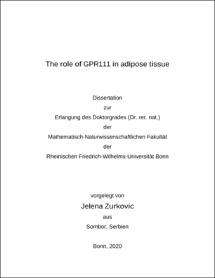The role of GPR111 in adipose tissue

The role of GPR111 in adipose tissue

| dc.contributor.advisor | Pfeifer, Alexander | |
| dc.contributor.author | Zurkovic, Jelena | |
| dc.date.accessioned | 2021-05-21T07:13:07Z | |
| dc.date.available | 2021-05-21T07:13:07Z | |
| dc.date.issued | 21.05.2021 | |
| dc.identifier.uri | https://hdl.handle.net/20.500.11811/9096 | |
| dc.description.abstract | Due to obesity pandemic and limited therapeutic approaches, novel targets of pharmaceutical treatments are urgently needed. AT as a very important metabolic organ is an attractive target for combating obesity and obesity related metabolic diseases.
Humans possess two different types of adipose tissue: BAT and WAT. WAT is important as main energy storage, whereas BAT dissipates energy in the form of heat (Chen et al., 2016). Our research group has shown that among GPCRs, aGPCRs are highly represented in pre- and mature brown adipocytes. One of the identified receptors was the orphan GPR111, which belongs to F subgroup of aGPCRs. The data presented in this study identified the role of Gpr111 in AT. In vitro data which were obtained using KO BAs and WAs, show that lack of Gpr111 promotes adipo- and thermogenesis. That was manifested through an increase of adipogenic and thermogenic markers, higher lipolytic rate and higher oxygen consumption in KO cells. Also, it is important to emphasise a massive browning effect that was observed in KO WAs. Due to a lack of ligands for Gpr111, the detailed investigation of signalling pathways was difficult. However, I could show that Gpr111 probably signals into the cilium and is tightly linked to HH and cAMP signalling. Furthermore, I could demonstrate that Gpr111 is involved in cell adhesion and cell organization especially after mechanical sheer stress was applied. Lack of Gpr111 has a big impact on cilia number and important genes of HH signalling, which were downregulated in KO cells as well as in some ATs. Adult Gpr111 KO mice showed a higher expression of adipogenic and thermogenic markers, higher EE and 15 % less fat mass. Measurement of oxygen consumption performed on explanted fat tissues was also higher in KO then in WT. Additionally, expression of UCP1 was increased in fat tissues of KO mice. According to these results I could conclude that a lack of Gpr111 induces browning phenotype in mice. Apart from investigation of Gpr111 mice under basal condition, in this study I challenged Gpr111 WT and KO mice with cold exposure and feeding them with HFD. Under cold stimulation KO mice show lightly higher EE in vivo. On the other hand, qPCR, Western blot and immunohistochemistry show massive browning in KO WAT, but unexpectedly KO mice had higher motility, food intake in comparison to WT and correspondingly more fat and muscle mass. As it was discussed before, possible reason for that is not related to AT, but to global deletion of Gpr111 and thermal stress. To reduce these unexpected results under cold stimulation the use of tissue specific KO model and exposing the mice to 4°C for shorter time were proposed. The most important challenge is HFD and KO mice fed with HFD show minor increase in EE. They also developed diabetes, food intake in KO HFD was much higher than in WT HFD and Western blot analysis has shown less UCP1 on protein level. Probably KO mice are resistant to HFD in young age and later on they develop obesity in a similar manner as WT mice. The HFD feeding at young age and tissue specific KO would give more explanations to this puzzle. In conclusion, my study identifies a previously unknown role for Gpr111 in energy metabolism. I provided evidence that depletion of Gpr111 promotes browning of adipose tissue. Thus, Gpr111 may be a pharmacological target to combat obesity and associated morbidities given its selective impact on WAT browning. | en |
| dc.language.iso | eng | |
| dc.rights | In Copyright | |
| dc.rights.uri | http://rightsstatements.org/vocab/InC/1.0/ | |
| dc.subject | Gpr111 | |
| dc.subject | Adipositas | |
| dc.subject | GPCR | |
| dc.subject | Ciliopathie | |
| dc.subject | Fettgewebe | |
| dc.subject | Gpr111 KO Mäuse | |
| dc.subject | obesity | |
| dc.subject | ciliopathy | |
| dc.subject | adipose tissue | |
| dc.subject | Gpr111 KO mice | |
| dc.subject.ddc | 500 Naturwissenschaften | |
| dc.title | The role of GPR111 in adipose tissue | |
| dc.type | Dissertation oder Habilitation | |
| dc.publisher.name | Universitäts- und Landesbibliothek Bonn | |
| dc.publisher.location | Bonn | |
| dc.rights.accessRights | openAccess | |
| dc.identifier.urn | https://nbn-resolving.org/urn:nbn:de:hbz:5-62366 | |
| ulbbn.pubtype | Erstveröffentlichung | |
| ulbbnediss.affiliation.name | Rheinische Friedrich-Wilhelms-Universität Bonn | |
| ulbbnediss.affiliation.location | Bonn | |
| ulbbnediss.thesis.level | Dissertation | |
| ulbbnediss.dissID | 6236 | |
| ulbbnediss.date.accepted | 24.03.2021 | |
| ulbbnediss.institute | Medizinische Fakultät / Institute : Institut für Pharmakologie und Toxikologie | |
| ulbbnediss.fakultaet | Mathematisch-Naturwissenschaftliche Fakultät | |
| dc.contributor.coReferee | Müller, Christa E. | |
| ulbbnediss.contributor.gnd | 1235754294 |
Files in this item
This item appears in the following Collection(s)
-
E-Dissertationen (4379)




